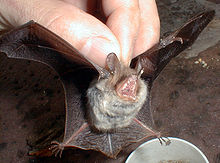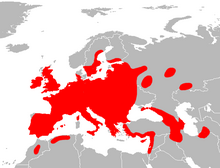Natterer's Bat
| Natterer's bat | |
|---|---|
 |
|
| Scientific classification | |
| Kingdom: | Animalia |
| Phylum: | Chordata |
| Class: | Mammalia |
| Order: | Chiroptera |
| Family: | Vespertilionidae |
| Genus: | Myotis |
| Species: | M. nattereri |
| Binomial name | |
|
Myotis nattereri (Kuhl, 1817) |
|
 |
|
Natterer's bat (Myotis nattereri) is a European vespertilionid bat with pale wings. It has brown fur tending to greyish-white on its underside. It is found across most of the continent of Europe, parts of the Near East and North Africa. It feeds on insects and other invertebrates which it catches on the wing or pursues on the ground.
In summer it roosts in deciduous and coniferous trees, buildings or bat boxes close to its feeding habitats. In winter it hibernates in caves, tunnels, mines or cellars, usually hiding in crevices. This bat was first described in 1817 by Heinrich Kuhl, who named it in honour of the Austrian naturalist Johann Natterer.
Natterer's bat is a medium-sized species and grows to a head and body length of 1.75 to 2 inches (44 to 51 mm) with a forearm (elbow to wrist) length of 1.75 inches (44 mm). It weighs between 5 and 9.5 grams (0.18 and 0.34 oz). The short, dense fur on the dorsal (upper) surface of head and body is greyish-brown while the ventral (under) surface is whitish-grey. The ears and the wing membranes are smoky grey. This bat can be distinguished from other similar species by the fact that the free edge of the interfemoral membrane between the hind limbs is wrinkled and fringed with stiff, curved hairs and the calcar, a spur of cartilage that supports the membrane, is shaped like a "S".
Natterer's bat has a western Palaearctic distribution and is native to most of Europe, parts of the Middle East and parts of northern Africa. Its range extends from southern Sweden, Finland and western Russia in the north to Ireland, the United Kingdom, Spain and Portugal to the west. It extends eastwards to Ukraine, western and southwestern Asia Minor, the Levant, the Caucasus region, the Kopet Dag Mountains in Turkmenistan, Iran and northern Kazakhstan. Its southern limit is Morocco and Algeria, southwards as far as the Atlas Mountains. Records from North Africa are few in number and the population there is likely to be small. Its historic range included Norway, in which it is now a possibly extirpated species.
...
Wikipedia

